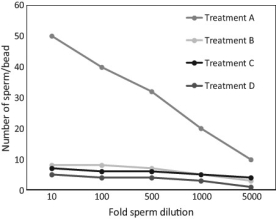Use the following information to answer the question.
In order to test how sea urchin sperm bind to eggs, scientists isolated the egg receptor protein that binds to the sperm acrosomal protein called bindin. Plastic beads were coated with egg receptor for bindin (ERB1) from eggs of the sea urchin Strongylocentrotus purpuratus, and then the beads mixed with sperm from S. purpuratus or from the related species, S. franciscanus. The researchers counted how many sperm were bound to each bead. The results are shown in the graph below. (Adapted from Kamei and Glabe 2003)
Treatments:
A: S. purpuratus sperm mixed with S. purpuratus ERB1 beads
B: S. purpuratus sperm mixed with beads containing no ERB1 protein
C: S. franciscanus sperm mixed with S. purpuratus ERB1 beads
D: S. franciscanus sperm mixed with beads containing no ERB1 protein
What is a broader implication from the observations of the experiment?
A) In sea urchins, fertilization of eggs by sperm is dependent upon species-specific protein interactions.
B) Only some species of sea urchins use receptor proteins on their eggs to bind sperm.
C) Protein-coated plastic beads should not be used to test sperm binding to eggs.
D) S. franciscanus is probably not a sea urchin, but must be some other type of organism.
Correct Answer:
Verified
Q5: A reproductive difference between sea urchins and
Q6: Contact of a sea urchin egg with
Q7: Fertilization of an egg without activation is
Q8: Among these choices, the largest cell involved
Q9: During fertilization, the acrosomal contents _.
A) block
Q11: In an egg cell treated with a
Q12: In a newly fertilized egg, the vitelline
Q13: As cleavage continues during frog development, the
Q14: In mammalian eggs, the receptors for sperm
Q15: At the moment of sperm penetration, human
Unlock this Answer For Free Now!
View this answer and more for free by performing one of the following actions

Scan the QR code to install the App and get 2 free unlocks

Unlock quizzes for free by uploading documents